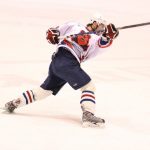Turning is one of the most important abilities for any hockey player to master. You may be able to turn, but how well are you able to do so? A significant difference is between a sluggish, meandering, off-balance turn vs. a rapid, tight, sharp turn. We’ll provide you the information you need to start performing better turns in this video and article.
How to Make a Hockey Turn
The Fundamentals of a Good Turn
Both skates should be used for a good turn. Sure, you can spin with just one skate on the ice, but with two blades on the ice, you’ll be better balanced and able to turn faster. The turn is broken down below.
- If you’re making a left turn, take the lead with your left foot. If you’re making a right turn, assume the information with your right foot.
- The majority of your weight will be on your outside leg with a staggered stance, and your inside skate will be there for extra balance and to assist you in getting lower (and a tighter turn)
- You can use both edges of the ice with both feet on the ice instead of just one.
- Use a couple of crossovers as you exit the corner to accelerate out and maintain your pace.
- Maintaining balance during the turn can be accomplished by staying low and having a solid base (feet are not too close together)
Examples from the NHL
Matt Duchene has a decent base and a staggered stance as he executes a tight spin. Duchene’s staggered stance not only aids his turn but also protects the ball from the defender!
Pavel Datsyuk competes in the NHL Skills Competition. The hands are away from the body, the stick guides Datsyuk through the spin, and he is low on the ice with both blades. Datsyuk can execute crossovers from this position while maintaining his speed as he completes this turn.
With the puck on the forehand, here’s a tight turn. Take note of the broad base for stability and balance (hard to knock off the puck). Karlsson’s hands are away from his torso, allowing him to cup the puck even more and turn even tighter. With his feet in this position, he may continue to push with his outer leg and drive wide while putting pressure on his opponent.

